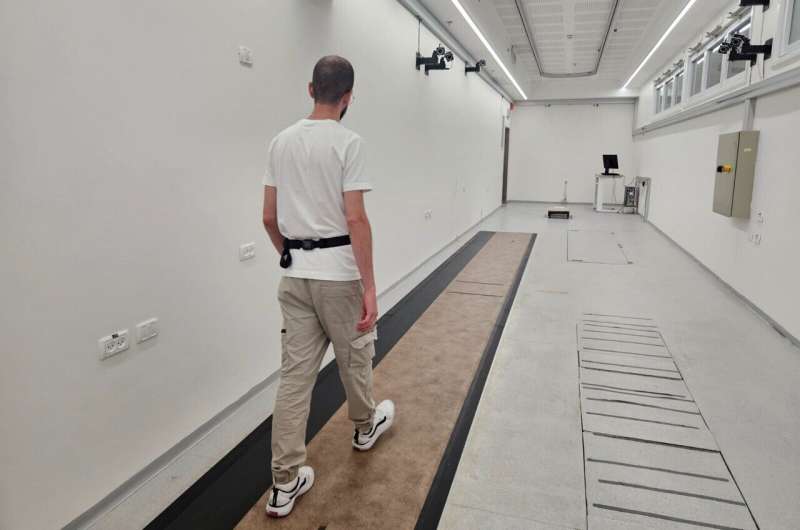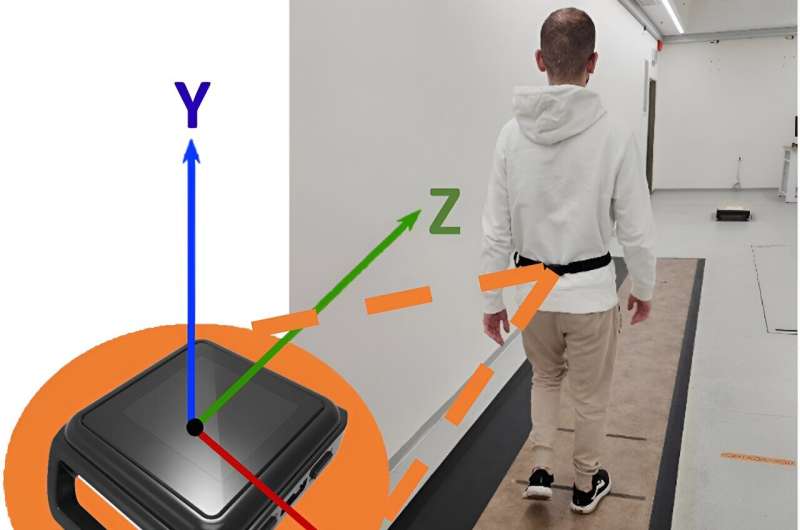This article has been reviewed according to Science X's editorial process and policies. Editors have highlighted the following attributes while ensuring the content's credibility:
fact-checked
peer-reviewed publication
trusted source
proofread
Accurate and continuous remote monitoring of step length can be sensitive marker for neurological diseases and aging

Researchers have used machine learning technologies to develop an algorithm that converts data from a small, lightweight, waterproof wearable sensor taped to the lower back into an accurate estimate of step length. The model is almost four times more accurate than the currently accepted biomechanical model.
The researchers explain, "Step length is a sensitive and non-invasive measure of a wide range of problems associated with aging, cognitive decline, and many neurological diseases, such as Parkinson's, Alzheimer's, and multiple sclerosis. Our model enables continuous monitoring of this key aspect of a patient's condition in daily life."
Researchers at Tel Aviv University and the Ichilov's Tel Aviv Sourasky Medical Center (Tel Aviv) led a multidisciplinary international study in which an innovative model based on machine learning was developed to accurately estimate step length. The new model can be integrated into a wearable device that is attached (with "skin tape") to the lower back and enables continuous monitoring of steps in a patient's everyday life.
"Step length is a sensitive measure of a wide range of problems and diseases, from cognitive decline and aging to Parkinson's. The conventional measuring devices that exist today are stationary and cumbersome, and are only found in specialized clinics and laboratories. The model we developed enables accurate measurement in a patient's natural environment throughout the day, using a wearable sensor," according to the researchers.
The study was led by Assaf Zadka, a graduate student in the Department of Biomedical Engineering at Tel Aviv University; Prof. Jeffrey Hausdorff from the Department of Physical Therapy at the Faculty of Medical and Health Sciences and the Sagol School of Neuroscience at Tel Aviv University, as well as from the Department of Neurology, Tel Aviv Sourasky Medical Center (TASMC); and Prof. Neta Rabin from the Department of Industrial Engineering at the Fleischman Faculty of Engineering at Tel Aviv University.
Also participating in the study were Eran Gazit from TASMC, Prof. Anat Mirelman from the Faculty of Medical and Health Sciences and the Sagol School of Neuroscience at Tel Aviv University and TASMC, as well as researchers from Belgium, England, Italy, Holland, and the U.S.. The research was supported by the Center for AI and Data Science of Tel Aviv University.
An article describing the research was published in the journal npj Digital Medicine.
Prof. Hausdorff, an expert in the fields of walking, aging, and neurology, explains, "Step length is a very sensitive and non-invasive measure for evaluating a wide variety of conditions and diseases, including aging, deterioration as a result of neurological and neurodegenerative diseases, cognitive decline, Alzheimer's, Parkinson's, multiple sclerosis , and more. Today it is common to measure step length using devices found in specialized laboratories and clinics, which are based on cameras and measuring devices like force-sensitive gait mats.
"While these tests are accurate, they provide only a snapshot view of a person's walking that likely does not fully reflect real-world, actual functioning. Daily living walking may be influenced by a patient's level of fatigue, mood, and medications, for example. Continuous, 24/7 monitoring like that enabled by this new model of step length can capture this real-world walking behavior."

Prof. Rabin, an expert in machine learning, adds, "To solve the problem, we sought to harness IMU (inertial measurement unit) systems—light and relatively cheap sensors that are currently installed in every phone and smart watch, and measure parameters associated with walking.
"Previous studies have examined IMU-based wearable devices to assess step length, but these experiments were only performed on healthy subjects without walking difficulties, were based on a small sample size that did not allow for generalization, and the devices themselves were not comfortable to wear and sometimes several sensors were needed.
"We sought to develop an efficient and convenient solution that would suit people with walking problems, such as the sick and the elderly, and would allow quantifying and collecting data on step length, throughout the day, in an environment familiar to the patient. The goal was to develop an algorithm that is capable of translating the IMU data into an accurate assessment of step length, which can be integrated into a wearable and comfortable device."
To develop the algorithm, the researchers used IMU sensor-based gait data, in addition to step length data measured conventionally in a previous study, from 472 subjects with different conditions, such as Parkinson's, people with mild cognitive impairment, healthy elderly subjects, as well as younger, healthy adults and people with multiple sclerosis. An accurate and diverse data base consisting of 83,569 steps were collected in this way.
The researchers used this data and machine learning methods to train a number of computer models that translated the IMU data into an estimate of step length. To test the robustness of the models, the researchers then determined to what extent the various models could accurately analyze new data that was not used in the training process—an ability known as generalization.
Zadka says, "We found that the model called XGBoost is the most accurate and is 3.5 times more accurate than the most advanced biomechanical model currently used to estimate step length. For a single step, the average error of our model was 6 cm—compared to 21 cm predicted by the conventional model.
"When we evaluated an average of 10 steps, we arrived at an error of less than 5 cm—a threshold known in the professional literature as 'the minimum difference that has clinical importance,' which allows identifying a significant improvement or decrease in the subject's condition. In other words, our model is robust and reliable, and can be used to analyze sensor data from subjects, some with walking difficulties, who were not included in the original training set."
Prof. Hausdorff concludes, "In our research we collaborated with researchers in diverse fields around the world, and the multi-disciplinary effort led to promising results. We developed a machine learning model that can be integrated with a wearable and easy-to-use sensor, which gives an accurate estimate of the patient's step length during daily life.
"The data collected in this way enables continuous, remote, and long-term monitoring of a patient's condition, and can also be used in clinical trials to examine the effectiveness of medications. Based on our encouraging results, we are looking into whether it is possible to develop similar models based on data from sensors in smart watches, which would further improve the comfort of the subject."
More information: Assaf Zadka et al, A wearable sensor and machine learning estimate step length in older adults and patients with neurological disorders, npj Digital Medicine (2024). DOI: 10.1038/s41746-024-01136-2




















